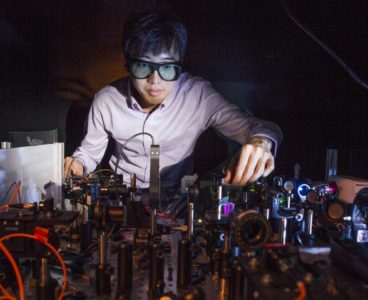Scientists from The Australian National University (ANU) have used new space technology to predict droughts and increased bushfire risk up to five months in advance. ANU researcher Siyuan Tian said the team knew they needed to move into space to get closer to understanding the complex nature of drought. They used data from multiple satellites…
New Optical Device Brings Quantum Computing a Step Closer
Scientists Detect Biggest Known Black-Hole Collision
An international team of scientists have detected ripples in space and time, known as gravitational waves, from the biggest known black-hole collision that formed a new black hole about 80 times larger than the Sun – and from another three black-hole mergers. The Australian National University (ANU) is playing a lead role in Australia’s involvement…
Study Witnesses First Moments of Star Dying in Finest Detail
For the first time, researchers have succeeded in creating an iron molecule that can function both as a photocatalyst to produce fuel and in solar cells to produce electricity. The results indicate that the iron molecule could replace the more expensive and rarer metals used today. Some photocatalysts and solar cells are based on a…
Fat From 558 Million Years Ago Reveals Earliest Known Animal
Scientists from The Australian National University (ANU) and overseas have discovered molecules of fat in an ancient fossil to reveal the earliest confirmed animal in the geological record that lived on Earth 558 million years ago. The strange creature called Dickinsonia, which grew up to 1.4 metres in length and was oval shaped with rib-like…
Tiny Camera Lens May Help Link Quantum Computers to Network
An international team of researchers led by The Australian National University (ANU) has invented a tiny camera lens, which may lead to a device that links quantum computers to an optical fibre network. Quantum computers promise a new era in ultra-secure networks, artificial intelligence and therapeutic drugs, and will be able to solve certain problems…
Scientists Discover the World’s Oldest Colors
Scientists from The Australian National University (ANU) and overseas have discovered the oldest colours in the geological record, 1.1 billion-year-old bright pink pigments extracted from rocks deep beneath the Sahara desert in Africa. Dr. Nur Gueneli from ANU said the pigments taken from marine black shales of the Taoudeni Basin in Mauritania, West Africa, were…
Sensor Tracks Gas Emitting from Skin and Breath
Australian National University Scientists from Australian National University have designed tiny optical sensors that open the door to developing a wearable device that allows doctors to medically diagnose people’s health in real time. Associate Professor Antonio Tricoli says the sensors, which are 50 times thinner than a human hair, promised to one day help doctors…
Astronomers Find Fastest-Growing Black Hole Known in Space
Astronomers at ANU have found the fastest-growing black hole known in the Universe, describing it as a monster that devours a mass equivalent to our sun every two days. The astronomers have looked back more than 12 billion years to the early dark ages of the Universe, when this supermassive black hole was estimated to…
Shatter-Proof Mobile Phone Screens a Step Closer
An international study on glass led by ANU and the Institut de Physique du Globe de Paris in France could lead to the development of shatter-proof mobile phone screens. Lead researcher Dr Charles Le Losq from ANU said the new knowledge, based on experiments and computer modelling, could be used to alter the structure of…
Team Invention May Help to Protect Astronauts from Radiation in Space
Scientists at The Australian National University (ANU) have designed a new nano material that can reflect or transmit light on demand with temperature control, opening the door to technology that protects astronauts in space from harmful radiation. Lead researcher Dr Mohsen Rahmani from ANU said the material was so thin that hundreds of layers could…
Butterfly Wings Inspire New Solar Technologies
Engineers have invented tiny structures inspired by butterfly wings that open the door to new solar cell technologies and other applications requiring precise manipulation of light. The inspiration comes from the blue Morpho Didius butterfly, which has wings with tiny cone-shaped nanostructures that scatter light to create a striking blue iridescence, and could lead to…
Brain-on-a-Chip Grown on Semiconductor Wafer
Australian National University researchers have developed a suitable material to allow brain cells to grow and form predictable circuits, which could lead to the development of prosthetics for the brain. Researchers grew the brain cells on a semiconductor wafer patterned with nanowires which act as a scaffold to guide the growth of brain cells. Lead…
Scientists Create New High-Tech Liquid Materials
Scientists at The Australian National University (ANU) have controlled wave-generated currents to make previously unimaginable liquid materials for new technological innovations, including techniques to manipulate micro-organisms. The new kind of dynamic material could be revolutionary, similar to other materials created in recent decades that have been used for invisibility cloaking, superlenses and high-efficiency antennae. Research…
A Step Closer to Sci-Fi Holograms
Australian National University physicists have invented a tiny device that creates the highest quality holographic images ever achieved, opening the door to imaging technologies seen in science fiction movies such as Star Wars. Lead researcher Lei Wang said the team created complex holographic images in infrared with the invention that could be developed with industry.…
Ancient Gecko Shines Light on Australian Desert Origins
Researchers have discovered an ancient species of gecko in the ranges of Central Australia which may shine new light on how and when Australia’s deserts began to form millions of year ago. Lead researcher Dr Paul Oliver from ANU said the velvet gecko Oedura luritja from the iconic ranges of Central Australia had been hiding in plain…
3D-Printed Fish Fossil May Reveal Origin of Human Teeth
Three-dimensional prints of a 400 million year old fish fossil from around Lake Burrinjuck in southeast Australia reveal the possible evolutionary origins of human teeth, according to new research by The Australian National University (ANU) and Queensland Museum. ANU and Queensland Museum digitally dissected the jaws of a fossil Buchanosteus – an armoured fish from…
Quantum Computing a Step Closer to Reality
Physicists at the Australian National University (ANU) have brought quantum computing a step closer to reality by stopping light in a new experiment. Lead researcher Jesse Everett said controlling the movement of light was critical to developing future quantum computers, which could solve problems too complex for today’s most advanced computers. “Optical quantum computing is still a…
Spray-on Waterproofing Material Protects Phones, Planes
Humans Have Caused Climate Change for 180 Years
A Little Impurity Makes Nanolasers Shine
Scientists at ANU (The Australian National University) have improved the performance of tiny lasers by adding impurities, in a discovery which will be central to the development of low-cost biomedical sensors, quantum computing, and a faster internet. Researcher Tim Burgess added atoms of zinc to lasers one hundredth the diameter of a human hair and…















